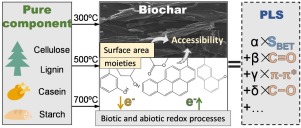当前位置:
X-MOL 学术
›
J. Hazard. Mater.
›
论文详情
Our official English website, www.x-mol.net, welcomes your
feedback! (Note: you will need to create a separate account there.)
Quantifying the contributions of surface area and redox-active moieties to electron exchange capacities of biochar.
Journal of Hazardous Materials ( IF 12.2 ) Pub Date : 2020-03-16 , DOI: 10.1016/j.jhazmat.2020.122541 Shasha Li 1 , Liming Shao 2 , Hua Zhang 3 , Pinjing He 2 , Fan Lü 3
Journal of Hazardous Materials ( IF 12.2 ) Pub Date : 2020-03-16 , DOI: 10.1016/j.jhazmat.2020.122541 Shasha Li 1 , Liming Shao 2 , Hua Zhang 3 , Pinjing He 2 , Fan Lü 3
Affiliation

|
Redox properties play a critical part in enabling biochar to participate in geochemical redox cycles. To manufacture biochar with targeted redox properties, it is essential to define the correlation of redox properties with the structure and moieties of biochar. However, previous studies focused on moieties, while structural parameters were overlooked. Furthermore, most publications used a single-factor analysis for certain types of moieties with other moieties possibly ignored. Herein, four kinds of representative biomass components, cellulose, lignin, casein, and starch, were pyrolyzed at low, intermediate, and high temperatures to obtain biochar with distinct structures and moieties. Then, the partial least-squares modeling was implemented to evaluate the quantitative contributions of structure and moieties to redox properties with the results obtained by characterizing the biochar. In addition to redox-active moieties, specific surface area was also found to be critical to the redox properties. The cellulose-derived chars exhibited better electron-donating capacities, while the lignin-derived chars exhibited better electron-accepting capacities. The starch-derived chars pyrolyzed at 700℃ possessed both high electron-donating and electron-accepting capacities. The casein-derived biochar exhibited weak redox capacities. These findings show the importance of structural influences on the redox properties and provide feedstock choices when applying and producing biochar with targeted redox properties.
中文翻译:

量化表面积和氧化还原活性部分对生物炭电子交换能力的贡献。
氧化还原特性在使生物炭参与地球化学氧化还原循环中起着至关重要的作用。为了制造具有目标氧化还原性质的生物炭,必须定义氧化还原性质与生物炭的结构和部分的相关性。但是,先前的研究集中在基团上,而结构参数却被忽略了。此外,大多数出版物对某些类型的部分使用单因素分析,而其他部分可能被忽略。在此,在低温,中温和高温下热解四种代表性的生物质组分,纤维素,木质素,酪蛋白和淀粉,以获得具有不同结构和部分的生物炭。然后,实施局部最小二乘建模以评估结构和部分对氧化还原特性的定量贡献,并通过表征生物炭获得结果。除了氧化还原活性部分之外,还发现比表面积对于氧化还原性质至关重要。纤维素衍生的炭表现出更好的给电子能力,而木质素衍生的炭表现出更好的电子接受能力。在700℃下热解的淀粉衍生炭具有较高的给电子和受电子能力。酪蛋白衍生的生物炭表现出弱的氧化还原能力。这些发现表明结构影响氧化还原性质的重要性,并在施用和生产具有目标氧化还原性质的生物炭时提供了原料选择。
更新日期:2020-03-16
中文翻译:

量化表面积和氧化还原活性部分对生物炭电子交换能力的贡献。
氧化还原特性在使生物炭参与地球化学氧化还原循环中起着至关重要的作用。为了制造具有目标氧化还原性质的生物炭,必须定义氧化还原性质与生物炭的结构和部分的相关性。但是,先前的研究集中在基团上,而结构参数却被忽略了。此外,大多数出版物对某些类型的部分使用单因素分析,而其他部分可能被忽略。在此,在低温,中温和高温下热解四种代表性的生物质组分,纤维素,木质素,酪蛋白和淀粉,以获得具有不同结构和部分的生物炭。然后,实施局部最小二乘建模以评估结构和部分对氧化还原特性的定量贡献,并通过表征生物炭获得结果。除了氧化还原活性部分之外,还发现比表面积对于氧化还原性质至关重要。纤维素衍生的炭表现出更好的给电子能力,而木质素衍生的炭表现出更好的电子接受能力。在700℃下热解的淀粉衍生炭具有较高的给电子和受电子能力。酪蛋白衍生的生物炭表现出弱的氧化还原能力。这些发现表明结构影响氧化还原性质的重要性,并在施用和生产具有目标氧化还原性质的生物炭时提供了原料选择。











































 京公网安备 11010802027423号
京公网安备 11010802027423号